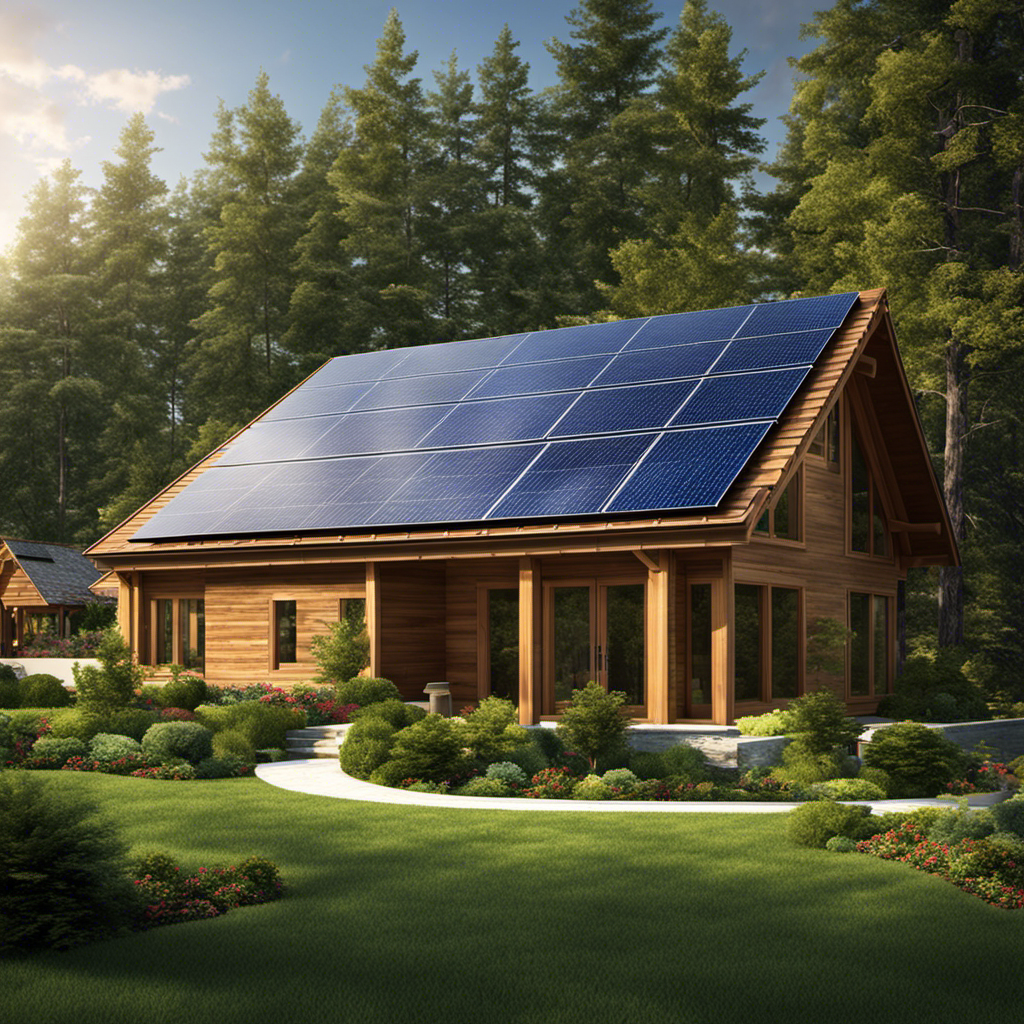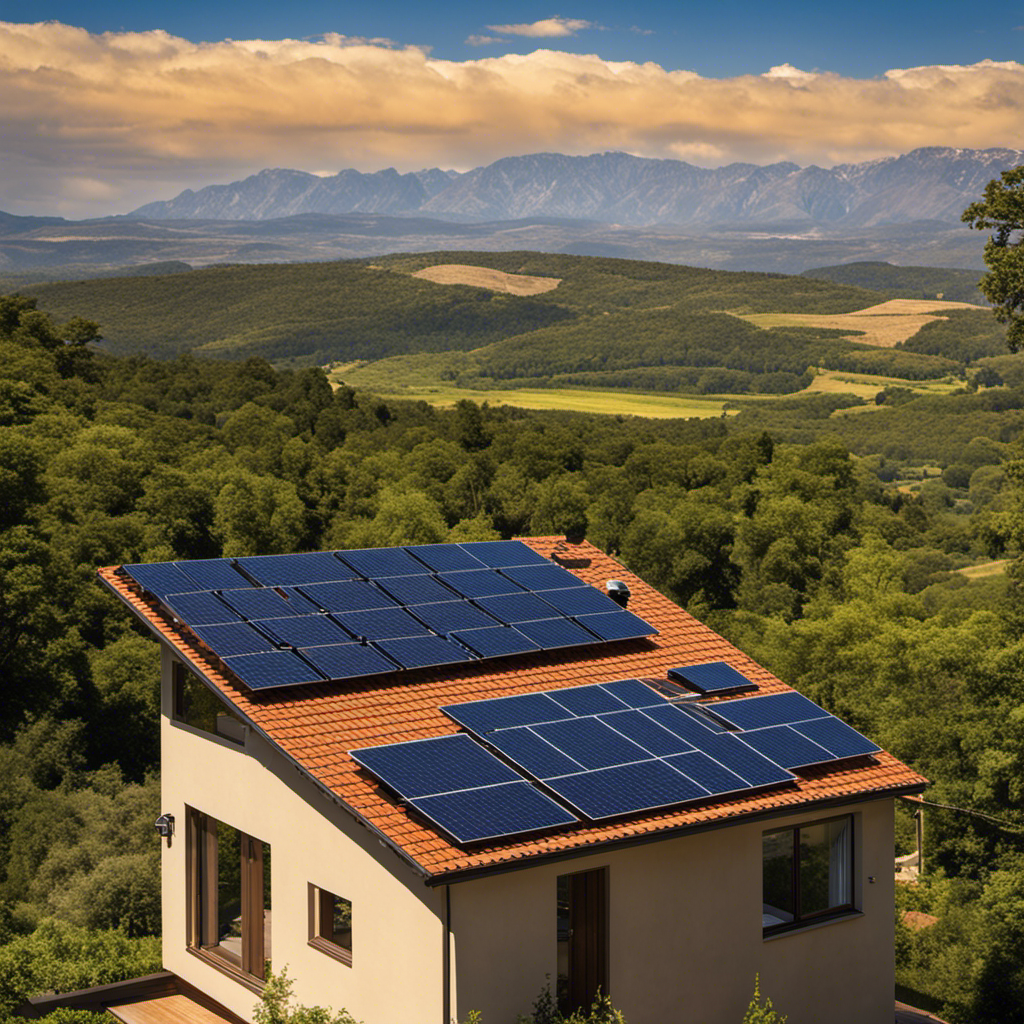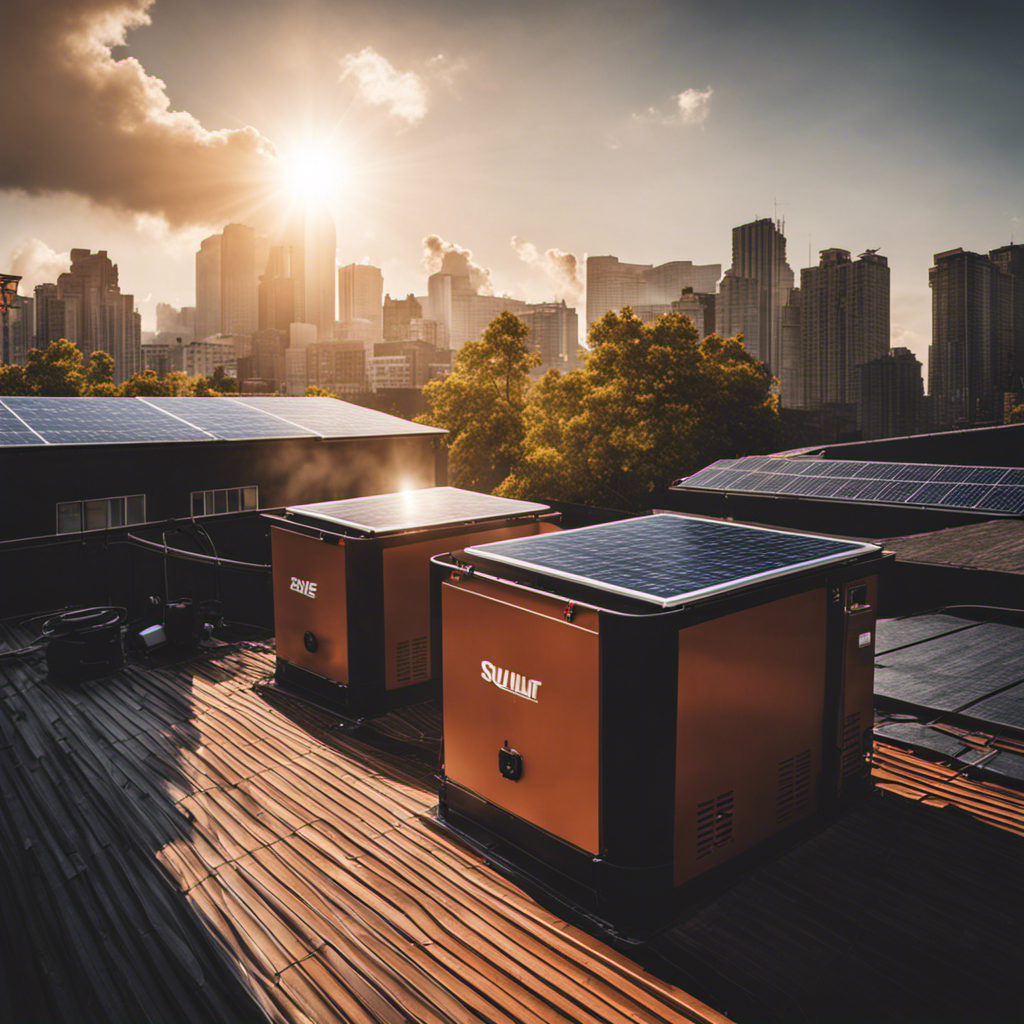Wind Energy Storage Solutions
Have you ever wondered how we can store the vast amounts of energy generated by wind turbines?
In this article, I will explore the various wind energy storage solutions that are revolutionizing the renewable energy industry.
From batteries to pumped hydro storage and compressed air energy storage, we will delve into the innovative technologies being developed.
Additionally, we will examine the advantages, challenges, and future trends in wind energy storage.
Join me as we uncover the exciting world of wind energy storage solutions.
Key Takeaways
- Wind energy storage is crucial for stabilizing the grid and ensuring a constant power supply.
- Storing excess energy helps reduce reliance on backup power sources and improves the overall efficiency of the electricity system.
- Advancements in battery technology have made wind energy storage more efficient and cost-effective.
- Integration of wind energy storage technologies, such as batteries, compressed air energy storage, hydrogen fuel cells, and flywheels, is essential for addressing the variability and scalability of wind energy generation.
The Need for Wind Energy Storage
The need for wind energy storage is becoming increasingly urgent due to the intermittent nature of wind power. As we rely more on wind energy to meet our electricity needs, it is crucial to find effective ways to store excess energy when it is produced and release it back into the grid when the wind is not blowing. This is where the advantages of wind energy storage come into play.
One of the key advantages of wind energy storage is the ability to stabilize the grid. By storing excess energy during times of high wind production, we can ensure a constant and reliable power supply, even when the wind is not blowing. This helps to reduce the reliance on backup power sources and improves the overall efficiency of the electricity system.
Another advantage of wind energy storage is the potential for cost savings. By storing excess energy, we can avoid the need for expensive peaker plants, which are typically used to meet periods of high demand. Additionally, with the advancement of technology, the cost of energy storage systems is expected to decrease in the future, making it a more viable solution for widespread adoption.
In terms of future trends in wind energy storage, research and development efforts are focused on improving the efficiency and capacity of storage systems. This includes advancements in battery technology, such as the use of lithium-ion batteries, which have shown promise in terms of cost-effectiveness and energy storage capacity.
Overall, the need for wind energy storage is crucial in ensuring a reliable and sustainable energy future. With the advantages it offers, along with ongoing research and development, we can expect to see significant advancements in wind energy storage solutions in the coming years.
Types of Wind Energy Storage Technologies
When it comes to wind energy storage, there are several options to consider.
Battery-based storage systems, such as lithium-ion batteries, are commonly used due to their high energy density and fast response times.
Compressed air energy storage systems, on the other hand, utilize excess wind energy to compress and store air, which can later be released to drive turbines and generate electricity.
Battery-Based Storage Options
You should consider using battery-based storage options for wind energy. Battery efficiency and long-term viability are key factors to consider when evaluating storage solutions for wind energy.
Batteries provide an efficient and reliable way to store excess energy generated by wind turbines, allowing for its use during periods of low or no wind. The advancements in battery technology have significantly improved their efficiency and lifespan, making them a viable option for long-term energy storage. Lithium-ion batteries, in particular, have proven to be highly efficient and durable, with the ability to store large amounts of energy.
Additionally, the decreasing costs of battery systems make them an increasingly attractive option for wind energy storage. However, it is crucial to continue research and development efforts to further improve battery efficiency and ensure their long-term viability.
Transitioning to the subsequent section about compressed air systems, another promising storage solution for wind energy is the use of compressed air.
Compressed Air Systems
Consider using compressed air systems as an alternative option for storing excess wind-generated electricity. Compressed air energy storage (CAES) has gained attention due to its potential in enhancing the efficiency of renewable energy integration. Here are three key reasons why compressed air systems are a viable solution:
-
High Efficiency: CAES facilities use excess electricity to compress air and store it in underground caverns. When electricity demand rises, the stored air is released to power turbines and generate electricity. Compared to battery-based storage options, CAES systems have higher energy conversion efficiency, resulting in reduced energy losses.
-
Renewable Energy Integration: Compressed air systems can help address the intermittent nature of renewable energy sources like wind. By storing excess wind-generated electricity during periods of low demand and releasing it during peak demand, CAES systems contribute to a more stable and reliable renewable energy grid.
-
Cost-effectiveness: CAES systems can be cost-effective compared to other energy storage options. The use of underground caverns for air storage eliminates the need for expensive materials, and the long lifespan of these facilities makes them a reliable and economical choice for wind energy storage.
Hydrogen Fuel Cells
Hydrogen fuel cells can provide a clean and efficient alternative for powering vehicles and other applications. The advancements in battery technology have significantly improved the performance and energy density of fuel cells, making them more viable for widespread use.
However, there are still several challenges and limitations that need to be addressed. One major challenge is the high cost of producing and storing hydrogen. While the cost of hydrogen production has been decreasing, it still remains a significant barrier to widespread adoption.
Additionally, the infrastructure for hydrogen refueling stations is limited, making it difficult for fuel cell vehicles to be widely accessible. Furthermore, the durability and longevity of fuel cells need to be improved to ensure their long-term reliability.
Despite these challenges, hydrogen fuel cells hold great potential as a sustainable energy solution and ongoing research and development efforts are focused on overcoming these limitations.
Batteries as Wind Energy Storage Solutions
Battery technology advancements and cost-effectiveness of batteries are key points to consider when discussing batteries as wind energy storage solutions. In recent years, there have been significant advancements in battery technology, with the development of more efficient and durable battery systems. These advancements have not only improved the performance of batteries but also made them more cost-effective, making them a viable option for storing wind energy.
Integration with wind farms is another important aspect to consider. Integrating batteries with wind farms allows for better management of fluctuating wind energy output. This is because batteries can store excess energy during times of high wind output and release it during times of low wind output. This helps to stabilize the energy supply and ensures a consistent flow of electricity to the grid.
Furthermore, integrating batteries with wind farms enables the storage of excess energy for later use. This is particularly beneficial during periods of low wind output or high electricity demand. By storing excess energy in batteries, wind farms can ensure a reliable and consistent supply of electricity, even when wind conditions are not optimal.
Battery Technology Advancements
You’ll be pleased to know that recent advancements in battery technology have made wind energy storage more efficient and cost-effective. These emerging technologies are revolutionizing the grid scale solutions for renewable energy storage.
Here are three key advancements in battery technology that are contributing to the improvement of wind energy storage:
-
Lithium-ion Batteries: These batteries have higher energy density and longer cycle life, making them ideal for storing wind energy at a grid scale. They offer improved efficiency and reduced costs compared to traditional lead-acid batteries.
-
Flow Batteries: This emerging technology utilizes liquid electrolytes stored in external tanks, allowing for easy scalability. Flow batteries have a longer lifespan, faster response times, and higher energy storage capacities, making them suitable for wind energy storage on a large scale.
-
Solid-State Batteries: These batteries use solid electrolytes instead of liquid or gel-like electrolytes. Solid-state batteries offer higher energy density, improved safety, and longer lifespan. They have the potential to revolutionize wind energy storage with their enhanced performance and reduced costs.
Overall, these advancements in battery technology are paving the way for more efficient and cost-effective wind energy storage solutions at a grid scale.
Cost-Effectiveness of Batteries
Due to recent advancements, the cost-effectiveness of batteries has greatly improved, making renewable energy sources more viable for widespread adoption. One of the key factors contributing to this improvement is the increased battery efficiency, which allows for better utilization of stored energy. This, in turn, leads to a more seamless integration of renewable energy into the grid. To illustrate this, let’s consider a comparison between battery technologies in terms of their cost and efficiency:
| Battery Type | Cost per kWh | Efficiency |
|---|---|---|
| Lithium-ion | $200 | 95% |
| Lead-acid | $150 | 80% |
| Flow | $250 | 90% |
| Sodium-ion | $180 | 85% |
As shown in the table, lithium-ion batteries have the highest efficiency and also a reasonable cost per kWh. This makes them a popular choice for storing renewable energy. With the increased cost-effectiveness of batteries, integrating renewable energy sources, such as wind farms, into the grid becomes more economically feasible.
Integration With Wind Farms
To maximize efficiency and reduce costs, it’s important to consider how well batteries can be integrated with wind farms. The integration of batteries with wind farms presents several challenges that need to be addressed for effective grid integration. Here are three key integration challenges:
-
Variability: Wind energy generation is highly variable, depending on the weather conditions. Batteries can help smooth out this variability by storing excess energy during high wind periods and supplying it during low wind periods.
-
Scalability: Wind farms are often large-scale installations, requiring a scalable storage solution. Batteries can be deployed in modular units to meet the specific energy storage requirements of different wind farms.
-
Grid compatibility: Integrating batteries with wind farms requires careful coordination with the existing power grid. This involves addressing issues such as voltage regulation, frequency control, and grid stability.
In conclusion, integrating batteries with wind farms brings numerous benefits, but it also poses significant challenges that need to be overcome for successful grid integration.
Transitioning to the subsequent section about ‘pumped hydro storage for wind energy’, another promising storage solution for wind farms.
Pumped Hydro Storage for Wind Energy
Pumped hydro storage is a popular solution for storing wind energy. It is a well-established technology that utilizes the potential energy stored in water to produce electricity. The efficiency of pumped hydro storage systems is quite impressive, with an average efficiency of around 70-85%. This means that for every unit of energy used to pump water uphill, the system can generate 0.7 to 0.85 units of electricity.
One of the key advantages of pumped hydro storage is its large capacity. These systems can store a significant amount of energy, ranging from a few megawatt-hours to several gigawatt-hours. The capacity of pumped hydro storage is determined by the size of the water reservoir and the vertical height difference between the upper and lower reservoirs. The larger the reservoir and the greater the height difference, the higher the storage capacity.
In terms of efficiency and capacity, pumped hydro storage is considered one of the most effective solutions for storing wind energy. However, its widespread deployment is limited by geographical constraints. Suitable sites for pumped hydro storage are often located in mountainous regions with access to large water bodies. As a result, the availability of such sites may be limited, especially in areas with high wind energy potential.
Transitioning to the next section, another promising solution for storing wind energy is compressed air energy storage (CAES). This technology utilizes excess wind energy to compress air, which is then stored in underground caverns or pressurized vessels. CAES systems have the potential to provide long-duration energy storage and can be deployed in a wider range of locations compared to pumped hydro storage.
Compressed Air Energy Storage (CAES) for Wind Power
If you’re considering alternative methods, compressed air energy storage (CAES) might be worth exploring for wind power. CAES is a technology that has gained attention for its potential in renewable energy storage.
Here are three key reasons why CAES is a promising solution for storing wind energy:
-
Efficiency: CAES systems have the ability to store large amounts of energy with relatively high efficiency. The process starts by using excess electricity generated by wind turbines to compress air and store it in underground caverns or tanks. When electricity is needed, the compressed air is released, and it drives a turbine to generate electricity. This closed-loop system ensures minimal energy losses, making CAES an efficient way to store and retrieve wind energy.
-
Scalability: CAES offers scalability, allowing for the storage of large amounts of wind energy. By using underground caverns or large storage tanks, CAES systems can store vast quantities of compressed air, enabling the storage of wind energy for extended periods. This scalability makes CAES suitable for utility-scale applications, where large amounts of wind energy need to be stored and released on demand.
-
Environmental Benefits: CAES has environmental benefits as it does not produce greenhouse gas emissions during energy storage or retrieval. Additionally, the technology can be paired with renewable energy sources like wind power, further reducing carbon emissions and enhancing the sustainability of the energy system.
Flywheels as Wind Energy Storage Systems
When considering flywheels as energy storage systems for wind farms, two important factors to examine are flywheel efficiency and capacity.
Flywheel efficiency refers to how well the system can convert and store energy. It is a crucial factor in determining the feasibility and effectiveness of integrating flywheels into wind farms. The higher the efficiency, the more energy can be effectively converted and stored.
Capacity, on the other hand, refers to the amount of energy that can be stored and utilized by the flywheel system. It is another crucial factor that directly impacts the overall performance and reliability of the system. A higher capacity means that more energy can be stored and utilized, which is beneficial for wind farms that need to store excess energy during periods of low demand.
Examining both flywheel efficiency and capacity is essential in evaluating the suitability of flywheels as energy storage systems for wind farms. By considering these factors, wind farm operators can make informed decisions about integrating flywheels into their energy storage infrastructure.
Flywheel Efficiency and Capacity
The flywheel’s efficiency and capacity are crucial factors to consider in wind energy storage solutions. As a research-oriented analyst of flywheel energy storage, I have explored various ways to optimize the capacity and efficiency of flywheels. Here are three key considerations for flywheel capacity optimization:
-
Material Selection: Choosing the right materials for the flywheel is essential to maximize its capacity. High-strength composite materials, such as carbon fiber, can provide the necessary strength while keeping the weight low.
-
Rotor Design: Optimizing the design of the flywheel rotor can significantly impact its capacity. By minimizing the hub size and increasing the diameter, more energy can be stored within the flywheel.
-
Control Systems: Efficient control systems are essential for managing the energy flow in and out of the flywheel. Sophisticated algorithms can regulate the rotational speed and ensure optimal charging and discharging processes.
Considering the importance of flywheel efficiency and capacity, it is crucial to integrate these optimized flywheel energy storage systems effectively with wind farms.
Integration With Wind Farms
To effectively integrate optimized flywheel systems with wind farms, it is crucial to consider the compatibility of the control systems.
Grid integration is an essential aspect of renewable energy storage, and wind farms are no exception. The ability to store excess energy generated by wind turbines and release it when needed is vital for a stable and reliable grid.
Flywheel systems offer a promising solution for energy storage due to their high power density and fast response time. However, integrating these systems with wind farms requires careful consideration of the control systems involved.
The control systems must be able to communicate and coordinate effectively to ensure seamless energy transfer between the wind turbines and the flywheel systems. This research-oriented approach ensures that the integration is optimized for maximum efficiency and reliability.
Thermal Energy Storage for Wind Power
You can use thermal energy storage to store excess wind power. This method allows for the integration of renewable energy sources, such as wind farms, into the existing power grid. Thermal storage systems work by converting excess wind power into thermal energy, which can be stored and used later when the demand for electricity is high.
Here are three key benefits of using thermal energy storage for wind power:
-
Grid Stability: One of the main challenges of renewable integration is the intermittent nature of wind power. By using thermal energy storage, excess wind power can be stored and released at times when the wind is not blowing or when the demand for electricity is high. This helps to stabilize the power grid and ensures a consistent and reliable electricity supply.
-
Increased Renewable Penetration: Thermal energy storage allows for a higher penetration of renewable energy sources in the power grid. By storing excess wind power, it becomes possible to use renewable energy even when the wind is not blowing. This reduces the reliance on fossil fuels and helps to reduce greenhouse gas emissions.
-
Cost Savings: Thermal energy storage systems can also result in cost savings. By storing excess wind power and using it during peak demand periods, there is less need to rely on expensive peaking power plants. This can lead to lower electricity costs for consumers and a more efficient use of resources.
Grid-Scale Energy Storage Options for Wind Energy
One option for grid-scale energy storage in wind power is through the use of battery systems. Battery storage technology has the potential to revolutionize the way we integrate wind energy into the grid, providing a reliable and efficient solution to the intermittent nature of wind power.
With the increasing adoption of wind turbines for electricity generation, the need for effective energy storage systems has become crucial for grid stability and reliability.
Grid integration of wind energy requires a storage solution that can store excess energy during periods of high generation and release it during periods of low generation. Battery systems offer this capability by converting electrical energy into chemical energy and storing it for later use. These battery systems can be charged during times of high wind generation and discharged when wind speeds are low, ensuring a continuous supply of electricity to the grid.
Thermal storage, another option for grid-scale energy storage, involves storing excess heat generated by wind turbines and using it to produce electricity when wind speeds are low. However, battery systems have gained more traction due to their higher efficiency and flexibility in storing and releasing energy.
Innovations in Wind Energy Storage Technology
In my previous subtopic, I discussed the various grid-scale energy storage options that can be utilized to store wind energy. Now, I will delve into the innovations in wind energy storage technology that are being developed to enhance the integration of renewable energy into the grid.
-
Advanced Battery Systems: One of the key innovations in wind energy storage is the development of advanced battery systems. These batteries, such as lithium-ion batteries, have higher energy density and longer lifespan compared to conventional batteries. They can store excess wind energy during times of low demand and release it when demand is high, ensuring a reliable and stable power supply.
-
Hydrogen Storage: Another innovative approach is the use of hydrogen as a storage medium for wind energy. Excess electricity generated by wind turbines can be used to produce hydrogen through electrolysis. The hydrogen can then be stored and used as a clean fuel for various applications, including power generation and transportation.
-
Flywheel Energy Storage: Flywheel energy storage systems are also gaining traction in the wind energy sector. These systems store excess wind energy by converting it into kinetic energy, which is stored in a spinning rotor. When the energy is needed, the rotor releases its stored energy, which is converted back into electricity. Flywheel systems offer high power output, fast response times, and a long operational life.
These innovations in wind energy storage technology are crucial for the effective integration of renewable energy into the grid. They enable the efficient utilization of wind energy resources, reduce reliance on fossil fuels, and contribute to a more sustainable and resilient energy system.
Continued research and development in this field will further enhance the capabilities of wind energy storage, making it a key pillar of the renewable energy transition.
Advantages of Wind Energy Storage Solutions
When it comes to advantages, the ability to store excess wind energy offers grid operators more flexibility in managing electricity supply and demand. Wind energy storage solutions have the potential to revolutionize the renewable energy sector by addressing the intermittent nature of wind power generation. By capturing and storing surplus wind energy, these solutions can ensure a more reliable and stable electricity supply.
One of the key advantages of wind energy storage is its ability to provide energy on demand. With the help of advanced storage technologies such as batteries and pumped hydro storage, excess wind energy can be stored and released when needed. This enables grid operators to better match electricity supply with demand, thereby reducing the reliance on traditional fossil fuel-based power plants. Furthermore, wind energy storage solutions can also help in mitigating the impact of sudden fluctuations in wind speed, ensuring a more consistent and reliable power supply.
Another advantage of wind energy storage is its potential to enhance grid stability and resilience. By storing excess wind energy during periods of low demand and releasing it during peak demand, these solutions can help manage load variations and reduce the risk of grid instability. This can be particularly beneficial in regions with high wind energy penetration, as it allows for better integration of wind power into the existing grid infrastructure.
In terms of applications, wind energy storage can be deployed at various scales, ranging from residential to utility-scale installations. At the residential level, small-scale battery storage systems can allow homeowners to store excess wind energy generated by residential wind turbines and use it during times of high electricity demand or when the wind is not blowing. On a larger scale, utility companies can invest in grid-scale storage solutions to optimize the use of wind energy and enhance grid reliability.
Challenges and Limitations of Wind Energy Storage
To overcome the challenges and limitations of wind energy storage, you will need to explore alternative technologies and strategies. Wind energy integration into the grid presents several challenges that need to be addressed for reliable and efficient power supply.
Here are three key challenges and limitations of wind energy storage:
-
Intermittency: Wind energy is inherently intermittent, meaning that it is not consistently available for power generation. This poses a challenge for grid operators who need to balance supply and demand in real-time. To address this challenge, energy storage technologies such as batteries and pumped hydro can be used to store excess wind energy during periods of high generation and release it during low wind periods to ensure a steady power supply.
-
Scalability: The scalability of wind energy storage systems is another limitation. Large-scale storage systems capable of storing significant amounts of wind energy are needed to provide reliable power to the grid. Current storage technologies often have limited storage capacities, which can hinder the integration of wind energy into the grid on a larger scale. Research and development efforts are focused on developing cost-effective and scalable storage solutions to overcome this limitation.
-
Grid Reliability: The integration of wind energy storage into the grid can impact its reliability. As wind energy generation fluctuates, the grid needs to be able to handle these variations and maintain a stable frequency. This requires advanced control systems and grid infrastructure upgrades to ensure seamless integration and grid stability.
Addressing the challenges and limitations of wind energy storage is crucial for the successful integration of wind power into the grid. By exploring alternative technologies and strategies, we can overcome these challenges and pave the way for a more reliable and sustainable energy future.
Future Trends in Wind Energy Storage
If you want to stay ahead of future trends in wind energy storage, exploring advancements in battery technology and grid integration is essential.
As the demand for renewable energy continues to grow, it is crucial to develop efficient and cost-effective solutions for storing wind energy.
One of the most promising advancements in this field is the development of advanced battery technologies.
Future advancements in battery technology hold great promise for wind energy storage.
Lithium-ion batteries, for example, have already proven to be a reliable and efficient option for storing energy.
However, researchers are constantly working on improving their performance and reducing costs.
New materials and designs are being explored to increase energy density and extend the lifespan of batteries.
Additionally, the integration of renewable energy sources with advanced battery storage systems can help overcome the intermittent nature of wind power and ensure a stable supply of electricity.
Economic viability is a major factor in determining the success of wind energy storage solutions.
Advancements in battery technology and grid integration must be cost-effective to be widely adopted.
Currently, the cost of batteries remains a significant barrier to large-scale deployment.
However, as technology advances and economies of scale are achieved, the cost of storage systems is expected to decrease.
Furthermore, government incentives and policies that promote renewable energy storage can also contribute to the economic viability of wind energy storage solutions.
In conclusion, the future of wind energy storage lies in advancements in battery technology and grid integration.
Researchers are continuously striving to develop more efficient and cost-effective storage solutions.
Frequently Asked Questions
How Does Wind Energy Storage Compare to Other Forms of Renewable Energy Storage, Such as Solar or Hydro?
Comparative analysis of wind energy storage compared to other forms of renewable energy storage, such as solar or hydro, reveals integration challenges.
Wind energy storage faces unique difficulties due to the intermittent nature of wind power generation.
While solar and hydro energy storage also have integration challenges, the unpredictability of wind patterns makes it more challenging to store and utilize wind energy efficiently.
Therefore, finding effective storage solutions for wind energy is crucial for its widespread adoption and integration into the renewable energy mix.
Can Wind Energy Storage Solutions Be Integrated Into Existing Power Grids Without Significant Upgrades?
Integrating wind energy storage solutions into existing power grids without significant upgrades poses scalability challenges. However, recent technological advancements have made it more feasible.
For instance, the use of advanced battery systems with higher storage capacities and faster charging capabilities can enhance the integration of wind energy into the grid.
Additionally, smart grid technologies that enable better management and distribution of power can help optimize the utilization of wind energy storage.
Are There Any Environmental Concerns Associated With Wind Energy Storage Technologies?
There are several environmental concerns associated with wind energy storage technologies. One of the main concerns is the impact on wildlife, particularly birds and bats, as wind turbines can pose a threat to their safety.
Additionally, the manufacturing and disposal of storage components can have negative sustainability implications, as they often require the use of rare earth metals and other resources.
Therefore, it is crucial to carefully assess and mitigate these environmental impacts when implementing wind energy storage solutions.
How Do Wind Energy Storage Solutions Impact the Overall Efficiency of Wind Power Generation?
When considering the implications of wind energy storage solutions, it is important to analyze their impact on the overall efficiency of wind power generation. These solutions have the potential to greatly enhance the effectiveness of wind power by allowing for the storage and use of excess energy during times of low demand.
This ensures a more consistent and reliable power supply, maximizing the efficiency of wind turbines. By incorporating effective storage solutions, we can optimize the utilization of wind energy resources.
What Are the Costs Associated With Implementing and Maintaining Wind Energy Storage Systems?
When it comes to wind energy storage systems, a thorough cost analysis is essential. The implementation and maintenance of these systems require careful consideration of various factors.
The costs associated with implementing wind energy storage solutions include the purchase and installation of the storage equipment, as well as any necessary upgrades to the existing infrastructure. Additionally, ongoing maintenance requirements, such as regular inspections and repairs, must be factored into the overall cost analysis.
Proper financial planning is crucial to ensure the long-term viability and success of wind energy storage systems.
Conclusion
In conclusion, wind energy storage solutions are crucial in addressing the intermittent nature of wind power.
Various technologies such as batteries, pumped hydro storage, and compressed air energy storage offer effective ways to store excess wind energy and release it when needed.
These innovations not only contribute to a more reliable and stable grid system but also help in reducing greenhouse gas emissions.
However, challenges and limitations such as high costs and limited scalability need to be addressed for wider adoption.
Future trends in wind energy storage focus on advancements in technology and cost reduction, paving the way for a more sustainable energy future.














